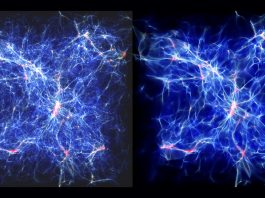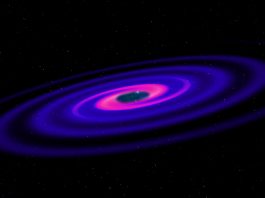Researchers have determined the possibility that dark energy – the mysterious force that causes the Universe to accelerate – has been detected.
In a novel study conducted by a team the University of Cambridge, it has been revealed that the surprising and previously unexplained findings from the XENON1T experiment – performed deep below Italy’s Apennine Mountains – may have been caused by dark energy, as opposed to the dark matter the experiment intended to detect.
Explaining the results
The researchers built a physical model to aid in finding an explanation for the results, which could have emanated from dark energy particles generated in a region of the Sun with strong magnetic fields, though further experiments are necessary to verify this explanation. The team said that their study may be a significant step towards the direct detection of dark energy.
Everything that is visible to us – from plants and insects, to moons and stars – makes up less than 5% of the Universe. The rest is dark. Of this, around 27% is dark matter – the invisible force holding galaxies and the cosmic web together – and 68% is dark energy, which causes the Universe to expand at an accelerated rate.
Detecting mysterious dark energy
“Despite both components being invisible, we know a lot more about dark matter, since its existence was suggested as early as the 1920s, while dark energy wasn’t discovered until 1998,” explained Dr Sunny Vagnozzi from Cambridge’s Kavli Institute for Cosmology, the paper’s first author. “Large-scale experiments like XENON1T have been designed to directly detect dark matter, by searching for signs of dark matter ‘hitting’ ordinary matter, but dark energy is even more elusive.”
In order to detect dark energy, researchers typically search for gravitational interactions: the way gravity pulls objects around. On the largest scales, the gravitational effect of dark energy is repulsive, pulling things away from each other and thus making the Universe’s expansion accelerate.
Around a year ago, the XENON1T experiment described an unanticipated signal, or excess, over the expected background.
“These sorts of excesses are often flukes, but, once in a while, they can also lead to fundamental discoveries,” commented Dr Luca Visinelli, a researcher at Frascati National Laboratories in Italy, a co-author of the study. “We explored a model in which this signal could be attributable to dark energy, rather than the dark matter the experiment was originally devised to detect.”
When these surprising results were first observed, the most widely accepted explanation for the excess were axions – hypothetical, extremely light particles – created in the Sun. However, this explanation does not corroborate with the observations, as the amount of axions that would be needed to explain the XENON1T signal would significantly modify the evolution of stars much heavier than the Sun, conflicting what was observed.
The fifth force
Currently, we have a lot to learn about what exactly dark energy is, however the majority of physical models for dark energy lead to the existence of a ‘fifth force’. There are four fundamental forces in the Universe, and any phenomena that cannot be clarified by one of these forces is often referred to as the result of an unknown fifth force.
However, we understand that Einstein’s theory of gravity works extremely well in the local universe. Therefore, any fifth force connected to dark energy is undesirable and must be ‘hidden’ or ‘screened’ when it comes to small scales, and can only operate on the largest scales where Einstein’s theory of gravity is incapable of explaining the acceleration of the Universe. To hide the fifth force, many models for dark energy are equipped with so-called screening mechanisms, which dynamically hide the fifth force.
Chameleon screening
For this experiment, the researchers assembled a physical model that utilised a sort of screening mechanism called ‘chameleon screening’, in order to demonstrate that dark energy particles produced in the Sun’s strong magnetic fields could explain the XENON1T excess.
“Our chameleon screening shuts down the production of dark energy particles in very dense objects, avoiding the problems faced by solar axions,” added Vagnozzi. “It also allows us to decouple what happens in the local very dense Universe from what happens on the largest scales, where the density is extremely low.”
The researchers applied their model to demonstrate what would occur in the detector if the dark energy was created in a specific region of the Sun, known as the tachocline, where the magnetic fields are particularly strong.
“It was really surprising that this excess could in principle have been caused by dark energy rather than dark matter,” said Vagnozzi. “When things click together like that, it’s really special.”
Their findings indicate that experiments such as XENON1T, which are intended to detect dark matter, could also be utilised to detect dark energy. However, the original excess must be convincingly confirmed.
“We first need to know that this wasn’t simply a fluke,” concluded Visinelli. “If XENON1T actually saw something, you’d expect to see a similar excess again in future experiments, but this time with a much stronger signal.”
If the excess was the consequence of dark energy, forthcoming upgrades to the XENON1T experiment, and experiments following similar objectives such as LUX-Zeplin and PandaX-xT, mean that it could be possible to directly detect dark energy within the next decade.









